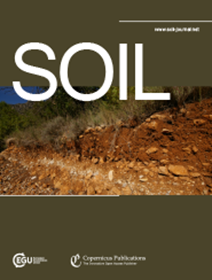A quantitative assessment of the behavior of metallic elements in urban soils exposed to industrial dusts near Dunkerque (northern France)
IF 4.3
2区 农林科学
Q1 SOIL SCIENCE
引用次数: 0
Abstract
Abstract. In urban and industrialized areas, soil contamination and degradation caused by industrial dust deposition may pose significant health and environmental risks. Generally, the mobility and thus bioavailability of potentially toxic elements (PTEs) are key factors in these issues. In the Dunkerque agglomeration, one of the most industrialized regions in France, the soils are periodically exposed to metallurgical dust fallout, rich in PTEs. However, no study has reported on the behavior of these PTEs once integrated into the soils. The aim of this study is therefore to assess the fate of PTEs in the urban soils of Dunkerque in terms of vertical migration and potential bioavailability. Four soil short cores were collected in the city of Gravelines (Dunkerque agglomeration) along a gradient from industrial emitters to deposition sites. Each soil core was cut into discrete 1 cm sections for PTE concentration analyses (ICP-AES/MS). Single HCl extractions were performed to evaluate PTE mobility in soils and their behavior according to the current soil parameters. For this purpose, key soil properties were identified, including grain-size distribution, mineralogy, pH, cation exchange capacity (CEC), TOC (total organic carbon), calcium carbonates and water contents in addition to the soil chemical composition (XRF, ICP-AES/MS). The studied soils revealed globally low absorbent capacities for pollutants (CEC averaging 5.3meq/100g), partially counterbalanced by the buffering effect of calcium carbonates (contents ranging from 8 %–30 %). Near the industrial emitters, minor (1法国北部敦刻尔克附近城市土壤中金属元素暴露于工业粉尘行为的定量评价
摘要。在城市和工业化地区,工业粉尘沉积造成的土壤污染和退化可能构成重大的健康和环境风险。一般来说,潜在有毒元素(pte)的流动性和生物利用度是这些问题的关键因素。在法国工业化程度最高的地区之一敦刻尔克地区,土壤定期暴露于富含pte的冶金粉尘沉降物中。然而,没有研究报道这些pte一旦进入土壤后的行为。因此,本研究的目的是从垂直迁移和潜在生物利用度的角度评估敦刻尔克城市土壤中pte的命运。在敦刻尔克集聚区沿工业排放点到沉积点的梯度收集了4个土壤短核。每个土壤岩心被切割成1厘米的离散切片,用于PTE浓度分析(ICP-AES/MS)。采用单次HCl提取,根据当前土壤参数评价PTE在土壤中的迁移率及其行为。为此,除了土壤化学成分(XRF、ICP-AES/MS)外,还鉴定了土壤的关键性质,包括粒度分布、矿物学、pH、阳离子交换容量(CEC)、总有机碳(TOC)、碳酸钙和水分含量。所研究的土壤总体上显示出较低的污染物吸收能力(CEC平均为5.3meq/100g),部分地被碳酸钙(含量范围为8% - 30%)的缓冲作用所抵消。在工业排放物附近,锰和镉的排放量为160%,锌的排放量约为44%。我们的研究指出,在当前的物理化学条件下(微碱性pH为7.8的钙质土壤),工业pte在土壤中的稳定性。在这种情况下,强烈建议监测这些城市土壤中的工业pte,考虑到(1)在排放者附近存在分配花园,(2)由于洪水事件增加而导致土壤条件的潜在演变。
本文章由计算机程序翻译,如有差异,请以英文原文为准。
求助全文
约1分钟内获得全文
求助全文
来源期刊

Soil
Agricultural and Biological Sciences-Soil Science
CiteScore
10.80
自引率
2.90%
发文量
44
审稿时长
30 weeks
期刊介绍:
SOIL is an international scientific journal dedicated to the publication and discussion of high-quality research in the field of soil system sciences.
SOIL is at the interface between the atmosphere, lithosphere, hydrosphere, and biosphere. SOIL publishes scientific research that contributes to understanding the soil system and its interaction with humans and the entire Earth system. The scope of the journal includes all topics that fall within the study of soil science as a discipline, with an emphasis on studies that integrate soil science with other sciences (hydrology, agronomy, socio-economics, health sciences, atmospheric sciences, etc.).
 求助内容:
求助内容: 应助结果提醒方式:
应助结果提醒方式:


